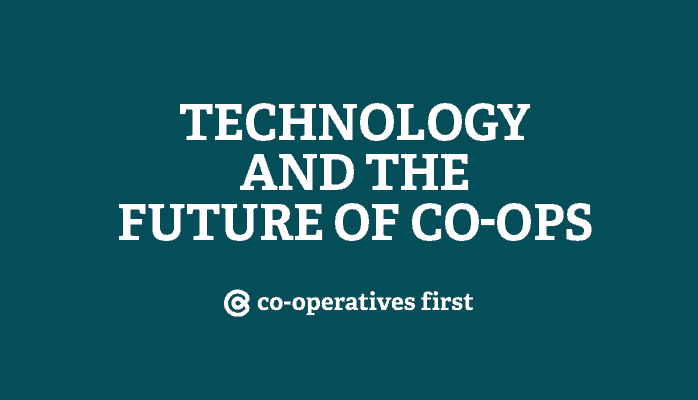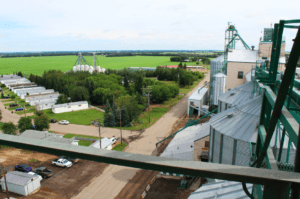The Future of rural co-ops
During the transition from steam and horse to fossil fuel, the co-op model really began to prove its worth as a tool for helping people work together. The model also helped rural farmers and businesses compete as local economies began interacting globally in the past. This raises the question: what does the future of rural co-ops look like?
The co-op model is a tool for organizing people and sharing resources in a way that is fair, efficient, and effective. It can also do a mean job of helping groups of people compete in a regional, national, or global marketplace. The model does this by increasing a group or individual’s capacity to participate within markets and economies they otherwise couldn’t.
So it shouldn’t be surprising that in the recent past rural communities benefited from using the co-op model, especially to provide vital utilities, supplies, and services. The future of co-ops, like their past, is once again well-positioned to support people living and working in rural and remote areas.
Working together to create opportunity
With the ongoing amalgamations of municipalities, growing influence of Tribal Councils and increasing sophistication of digital communication tools, there is increasing opportunity for working together. Co-ops have a place in capturing this opportunity.
We’re seeing it take place. The Saskatchewan Indigenous Technical Services Co-operative is a great example of First Nations and Tribal Councils working together to achieve quality, scale, and increased sovereignty.
But there is one key piece of modern infrastructure missing in a lot of rural and remote areas: broadband. To enter new markets, create capacity and grow new opportunities, both rural and Indigenous communities need consistent access to high-quality broadband.

Broadband is 21st Century infrastructure
The internet and the increasing dominance of online aggregators, like Amazon, Facebook and Google, continue to influence and develop the global economic landscape. The dominance of these global players presents a threat to small business and rural communities, much like Walmart in the early 2000s. But the opportunity that comes with connectivity is also great.
Like electricity or clean water, broadband is infrastructure necessary for survival in the current economic environment. If you want your town or business to succeed, they need access to broadband. To run competitive businesses, attract employees and their families, and be investment ready, broadband is a prerequisite.
“Cooperatives brought electricity to rural America when no one else would, and they’ve given Main Street a fighting chance against the big boxes. They help millions buy homes. They pioneered the local, organic revival and the means of delivering fairtrade products from across the planet. Next, the internet. We have done this already, and we can do it again, even better than before.” – Nathan Schneider
Despite a lot of heavy wind by various governments on the importance of rural broadband, little movement has been seen on the ground.
One way to combat this foot-dragging is to do it yourself. In the past, power, water and even an oil refinery was built on a DIY co-op principle. Broadband is today’s electricity. If others won’t do it for you, then you have to do it yourself.
Co-ops are a great option for those thinking of doing it themselves. By working together to bring broadband the “last mile,” rural communities and business can compete, innovate, and grow in a global marketplace.
Federation Innovation
The increasing footprint of transnational corporations and the challenges they place in front of small business has impacted rural communities particularly hard. Over time, an increase in urban factories and suburbs depleted people from rural areas. Better cars created quicker, safer drives for those who remained. The resulting regular trips to the city meant rural business revenues shrank.
To compete, small business needs to innovate and scale. One way these businesses can scale is by working together and thinking outside the box. The ubiquitous Co-op stores across western Canada are early, successful examples of this strategy.
By working together, independent stores were able to capture more of the supply chain and centralize distribution and administration so that they could compete with the growing strength of national and transnational corporate rivals.
Today, the opportunity to scale remains but the strength of it is based online and through modern communication tools.
“It needs to be easier for start-ups to see the co-op model as a viable option” – Nathan Schneider
Employees who work remotely, according to a 2-year Stanford University study, can be more productive and cost-effective. Plus, working remotely, thanks to online tools like Monday and Trello, has made developing a corporate structure and culture based on remote support more feasible, perhaps even more viable, for some business models.
Moreover, First Nations, municipalities, and independent businesses, such as small family farms and retail operations, have the growing opportunity to create partnerships that transcend traditional physical and geographical lines.
These partnerships can be facilitated and managed online and through an astute co-operative governance scheme.
Attract remote workers to your rural community
Online communication tools provide an opportunity for rural communities to attract those interested in rural living, but also benefitting from high-paying city office jobs, to work remotely.
The wages and families these remote workers bring with them would support local businesses and increase key population numbers for investment attraction and improve investment readiness. Forming a regional co-op that markets itself to urbanites with a desire to move to rural surroundings is an option.

Form platform co-ops
If you’re lucky enough to already have broadband, taking your existing business online is a great way to increase market reach.
Platform co-ops or co-op businesses based on an online presence instead of a storefront have been increasing in popularity in recent years. One early success story is Stocksy United out of Victoria, BC.
RELATED: Elevating an Industry: The Stocksy United Story
Like a lot of co-ops, Stocksy focuses on elevating the strengths of independent business owners. Instead of regulating independent photographers through a prescriptive stock photo pipeline, Stocksy celebrates the talent, individuality, and quality of an original artist. The result is the elevation of an industry and an incredibly unique and valuable product offering.
Research and development
In the same way Federated Co-operatives Limited provides wholesale, logistical, and administrative support to hundreds of independent retail co-ops across western Canada, small to medium business in rural areas could benefit from a research and development co-op that supplies equipment, talent, and space to test products.
By combining purchasing power and acquiring a mutually beneficial team of researchers, equipment, and facility, likeminded entrepreneurs, such as oil seed producers, could benefit from group purchasing power and aligned efforts.
The same could be done with small to medium manufacturers or industrial and ag equipment users or leasers. Sharing is easy, cost effective and efficient if you can get the governance right. The benefit to independent business and rural communities could be tremendous.

Joining forces to compete
To compete with global corporate forces, small to medium independent business and rural communities will have to join forces to compete. It’s not a matter of when but how and in what way. The co-op model is one of those ways.
A co-op needs to create value, says Nathan Schneider, “not just with the services [it] offer[s] to members, but with the connections [it] enable[s] among members – and the efficiencies…members discover together. [The co-op model’s] specialty [is] in fostering trust on trustless networks, federating local communities across the globe. And [these future co-ops] will build on the long co-operative legacy with forms of online governance that are more transparent than the competition and co-ops past.”
Did you enjoy this article on the future of rural co-ops with Nathan Schneider? You may also enjoy our podcast with him, The Future of Co-ops? A conversation with Nathan Schneider




